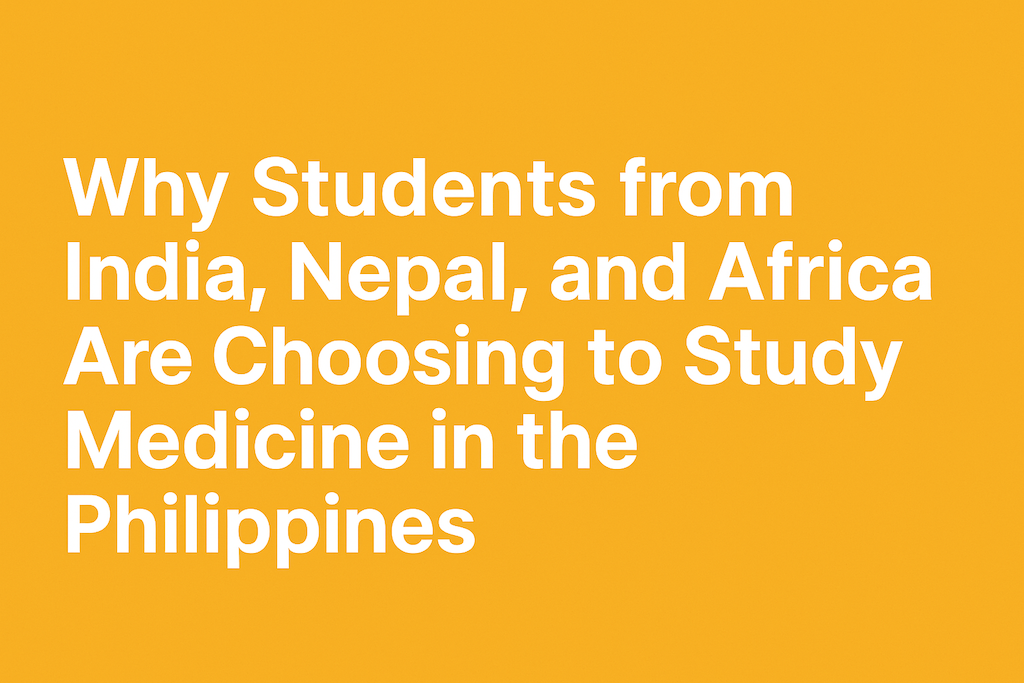Why Students from India, Nepal, and Africa Are Choosing to Study Medicine in the Philippines
Contents
- 1 Why Students from India, Nepal, and Africa Are Choosing to Study Medicine in the Philippines
- 2 1. Affordable Tuition and Cost of Living
- 3 2. English-Medium Instruction and Global Recognition
- 4 3. Eligibility for Medical Licensure in Home Countries
- 5 4. Cultural Compatibility and Diverse Student Population
- 6 5. Step-by-Step Admission Guide for International Students
- 7 6. Conclusion – A Smart Pathway to a Global Medical Career
- 8 Featured Medical Schools in Cebu
Why Students from India, Nepal, and Africa Are Choosing to Study Medicine in the Philippines
A Practical and Affordable Pathway to a Global Medical Career
Introduction
For aspiring doctors in countries like India, Nepal, and across Africa, gaining admission to a reputable medical school can be a frustrating and often unattainable goal. Intense competition, limited government seats, and soaring tuition fees at private institutions leave many qualified students without options—even when they possess the passion and academic potential to succeed in medicine.
In response to these challenges, thousands of students are now looking abroad for alternative solutions. Among the most attractive destinations is the Philippines—a country that offers English-based medical education, globally recognized degrees, and a culturally welcoming environment, all at a fraction of the cost of medical schools in Western countries.
This article explores why the Philippines has become a hub for international medical students from South Asia and Africa. We will examine the practical benefits of studying medicine in the Philippines, including tuition affordability, medium of instruction, eligibility for medical licensure in your home country, and what to expect during the application process. If you’re a student who dreams of becoming a doctor but feels limited by circumstances in your home country, the Philippines may offer you a smart, realistic, and empowering alternative.
1. Affordable Tuition and Cost of Living
One of the most compelling reasons why international students choose the Philippines for medical education is its affordability. Compared to the cost of studying medicine in countries like the United States, United Kingdom, Australia, or even private institutions in India and Africa, the Philippines offers a far more accessible alternative.
📚 Tuition Fees
Medical programs in the Philippines typically cost between $3,000 to $8,000 USD per year. Even the most reputable institutions remain within reach for students from middle-income families. In contrast:
-
Private medical colleges in India can charge over $15,000 to $25,000 USD per year.
-
Medical schools in the UK or Australia often exceed $40,000 USD per year, not including living expenses.
This drastic difference in tuition allows students to pursue their dreams without putting their families under extreme financial pressure or taking on lifelong debt.
🏠 Cost of Living
In addition to tuition, living expenses in the Philippines are relatively low.
Here’s a rough monthly breakdown for a typical student living in Cebu or Manila:
| Expense Category | Estimated Cost (USD/month) |
|---|---|
| Accommodation (shared) | $150 – $300 |
| Meals (3x per day) | $120 – $200 |
| Transport & Mobile | $30 – $50 |
| Miscellaneous (study materials, social life) | $50 – $100 |
➡️ Total Monthly Living Cost: $350 – $650 USD
Even with tuition and living expenses combined, the overall cost of studying medicine in the Philippines is significantly lower than in most other English-speaking countries.
💡 Budget-Friendly but High-Quality
While the Philippines is considered affordable, the quality of education is not compromised. Most medical schools follow U.S.-style curricula and employ English-speaking faculty with advanced degrees and international experience. Students receive solid theoretical foundations and hands-on clinical training in accredited teaching hospitals.
2. English-Medium Instruction and Global Recognition
The Philippines is one of the few countries in Asia where English is the official language of instruction at all levels of education, including medical schools. This unique feature makes the country an ideal destination for international students, especially those from non-English-speaking countries who want to pursue a global medical career.
🗣️ No Language Barrier
In many countries, international students must first learn the local language before they can fully participate in lectures or interact with patients during clinical rotations. In the Philippines, this is not the case. All medical classes, textbooks, exams, and even hospital training are conducted in English, eliminating one of the biggest barriers faced by foreign students.
This allows students to focus entirely on medical knowledge instead of spending valuable time and energy learning a new language. It also improves their communication skills for international licensing exams and global medical practice.
🌍 Recognition by Global Medical Bodies
Medical degrees from the Philippines are widely recognized around the world. Most reputable universities are listed in:
-
The World Directory of Medical Schools (WDOMS)
-
The World Health Organization (WHO)
-
The Educational Commission for Foreign Medical Graduates (ECFMG) (required for the USMLE)
-
The General Medical Council (GMC) in the UK (with certain conditions)
This means that graduates of Philippine medical schools are eligible to take licensure exams such as:
-
USMLE (United States Medical Licensing Examination)
-
PLAB (Professional and Linguistic Assessments Board) in the UK
-
AMC Exam (Australian Medical Council)
-
FMGE / NExT in India
-
NMC Licensing Exam in Nepal
-
Medical Council Exams in Nigeria, Kenya, South Africa, and other African nations
🏥 U.S.-Style Curriculum
Most medical schools in the Philippines follow a U.S.-based MD (Doctor of Medicine) curriculum that combines theoretical studies with hospital-based clinical rotations. This format prepares students not only for local practice but also for international careers.
3. Eligibility for Medical Licensure in Home Countries
One of the most critical concerns for international students studying medicine abroad is whether their degree will be accepted in their home country. The good news is that medical degrees from the Philippines are eligible for licensure exams in many countries across South Asia and Africa, provided the student meets certain conditions.
Let’s take a closer look at how this works in specific countries:
🇮🇳 India – FMGE and NExT
Graduates of Philippine medical schools are eligible to take the Foreign Medical Graduate Examination (FMGE) administered by the National Board of Examinations (NBE) in India. Passing this exam allows graduates to register with the National Medical Commission (NMC) and practice medicine in India.
From 2024–2025 onward, the FMGE will gradually be replaced by the National Exit Test (NExT), which will also apply to both domestic and foreign medical graduates.
Many Indian students choose the Philippines because of its high FMGE pass rates compared to countries like China or Ukraine.
🇳🇵 Nepal – NMC Licensing Exam
Students from Nepal who graduate from a WDOMS-listed medical school in the Philippines can take the Nepal Medical Council (NMC) Licensing Examination. The NMC recognizes many Philippine medical schools, especially those with strong academic credentials and English-based instruction.
🌍 African Countries – Nigeria, Kenya, South Africa & Others
Many African countries, including Nigeria, Kenya, Ghana, and South Africa, allow foreign-trained doctors to apply for licensure if their degrees are from recognized institutions.
Graduates are typically required to:
-
Provide documentation from a WDOMS- or WHO-listed school
-
Pass a local licensing exam or internship assessment
-
Meet English proficiency requirements
-
In some cases, complete a bridging program or supervised clinical internship
Students from these regions often prefer the Philippines due to its clinical exposure, affordable costs, and cultural familiarity, as well as the ability to complete their education in English.
✅ What You Need to Ensure Eligibility
Regardless of your home country, here are a few steps to protect your eligibility for licensure:
-
Enroll in a recognized, accredited medical university (listed in WDOMS)
-
Keep detailed records of your academic transcripts and clinical rotations
-
Maintain your English proficiency (some countries require proof)
-
Review your country’s specific requirements before applying to any medical school
4. Cultural Compatibility and Diverse Student Population
Studying abroad can be a life-changing experience—but it can also be intimidating, especially when students are faced with language barriers, culture shock, or social isolation. Fortunately, the Philippines offers a culturally compatible and welcoming environment for students from India, Nepal, and African nations.
🤝 A Friendly, English-Speaking Society
Filipinos are known for their warm hospitality and friendliness toward foreigners. As an English-speaking country, students rarely struggle with day-to-day communication. Whether you’re asking for directions, shopping for groceries, or speaking with professors, you’ll be able to function in English comfortably.
This openness significantly reduces the stress of adapting to a new environment—something many international students worry about when considering countries like China, Russia, or Eastern Europe.
🌏 Multinational Classrooms
Medical schools in the Philippines host a diverse population of international students, including:
-
🇮🇳 India
-
🇳🇵 Nepal
-
🇳🇬 Nigeria
-
🇰🇪 Kenya
-
🇸🇦 Saudi Arabia
-
🇸🇴 Somalia
-
🇬🇭 Ghana
-
🇵🇰 Pakistan
-
🇧🇩 Bangladesh
-
and many more
This diversity fosters a global academic environment, where students not only learn medicine but also gain cross-cultural communication skills and build a worldwide professional network.
🍛 Food and Religious Considerations
The Philippines has a wide variety of food options that cater to different dietary needs, including vegetarian, halal, and spicy cuisines preferred by many South Asian and African students. In urban areas like Cebu and Manila, it’s common to find Indian restaurants, African grocery stores, and places of worship including Hindu temples, mosques, and churches.
🕌 Religious Freedom and Tolerance
The Philippines is a predominantly Christian country, but it is known for its religious tolerance. Students from all backgrounds—Muslim, Hindu, Christian, or others—can practice their faith freely and openly.
In short, the Philippines offers a student-friendly, culturally adaptable environment where international students from various backgrounds can feel at home while pursuing a world-class medical education.
5. Step-by-Step Admission Guide for International Students
Applying to a medical school in the Philippines is a relatively straightforward process, especially compared to more bureaucratic or exam-heavy systems in other countries. Here’s a clear step-by-step guide to help future students from India, Nepal, Africa, and other regions understand the process.
✅ Step 1: Verify Eligibility Requirements
Before applying, confirm that your educational background meets the minimum criteria:
-
Completion of 12 years of formal education (equivalent to high school or A-levels)
-
Strong academic performance in Biology, Chemistry, and Physics/Mathematics
-
English language proficiency (some schools require IELTS/TOEFL; many do not)
Note: Some students may need to complete a Bachelor’s degree or pre-medical program before entering the MD program.
✅ Step 2: Choose an Accredited Medical School
Make sure the university is:
-
Listed in the World Directory of Medical Schools (WDOMS)
-
Recognized by WHO, ECFMG, or your home country’s Medical Council
-
Offering a full Doctor of Medicine (MD) program (4 years, U.S.-style)
Examples include Cebu Doctors’ University (CDU), Southwestern University PHINMA (SWU), and the University of the Visayas (UV Gullas).
✅ Step 3: Submit Your Application
Most schools allow you to apply online. Typical requirements include:
-
Application form
-
Academic transcripts
-
Passport copy
-
Passport-size photos
-
Certificate of Good Moral Character
-
Application fee (usually $100–$150 USD)
✅ Step 4: Take the NMAT (National Medical Admission Test)
The NMAT is a standardized exam required for entry into most medical schools in the Philippines. It includes sections on:
-
Verbal and quantitative reasoning
-
Biology, Chemistry, Physics
-
Social sciences and inductive reasoning
Many universities allow students to begin pre-medical coursework before taking the NMAT, then transition into the MD program once the test is passed.
✅ Step 5: Secure a Student Visa (9F Visa)
Once accepted, students must apply for a 9F student visa through the Philippine embassy or directly in the Philippines after arrival (with a tourist visa conversion). Required documents include:
-
Acceptance letter
-
Passport with valid tourist visa
-
Birth certificate
-
Medical exam results
-
Financial support documents
-
NBI/police clearance (if applicable)
✅ Step 6: Arrive and Begin Pre-Med or MD Program
Upon arrival, students attend orientation, undergo placement processes, and begin either:
-
A Pre-Medicine program (usually 1–2 years)
-
Or, if already eligible, directly enter the 4-year MD program
This step-by-step guide helps demystify the process and gives students a clear roadmap to follow. With proper preparation and documentation, the transition into Philippine medical education is smooth and achievable.
6. Conclusion – A Smart Pathway to a Global Medical Career
For thousands of ambitious students from India, Nepal, and across Africa, the path to becoming a doctor can feel narrow, competitive, and incredibly expensive. But it doesn’t have to be.
The Philippines offers an alternative—one that is affordable, internationally recognized, English-speaking, and culturally welcoming. Students receive a high-quality medical education that prepares them not just for local practice, but for global licensure exams and international careers.
With lower tuition costs, US-style curricula, diverse student communities, and compatibility with licensing systems in India (FMGE/NExT), Nepal (NMC), Nigeria, Kenya, and beyond, the Philippines is increasingly becoming the top choice for future doctors who think globally.
Choosing to study medicine abroad is a major decision. But for those who are ready to invest in their future without sacrificing quality or accessibility, the Philippines presents a compelling, proven, and life-changing option.
If you dream of becoming a doctor—and you’re looking for a realistic, practical way to get there—consider the Philippines as your launchpad.
Featured Medical Schools in Cebu
Here are three of the most popular medical universities in Cebu that welcome international students:
1. Southwestern University PHINMA (SWU)
Known for its modern campus and international programs, SWU PHINMA offers a Doctor of Medicine program recognized across Asia and the Middle East. The university has long experience hosting students from India, Africa, and the Middle East.
→Southwestern University PHINMA (SWU)
2. Cebu Doctors’ University (CDU)
CDU is one of the top-ranked medical universities in the Visayas region. With its strong clinical training and partnerships with hospitals, it’s a popular choice for serious medical students aiming for global licensure.
→Cebu Doctors’ University (CDU)
3. University of the Visayas – Gullas College of Medicine (UV Gullas)
UV Gullas offers a flexible and affordable medical program tailored for international students. The campus provides a supportive environment for newcomers adjusting to the Philippine education system.
→University of the Visayas – Gullas College of Medicine (UV Gullas)



